
Multiple orb webs built along a fence.
Image courtesy of Pixabay, licensed under CC0.
Spider webs: not just for Halloween
Lisa Hendry
Dusty spider webs are associated with Halloween and creepy houses, but many are beautiful or architecturally accomplished.
Did you know that you can tell what kind of spider is lurking by the threads it spins?
A web isn't a foolproof way of identifying the spider that made it, but its shape will usually allow you to establish which family it comes from, and it's often possible to be even more specific. Here we outline the main web structures that UK spiders use to catch their prey and the common architects of each kind.
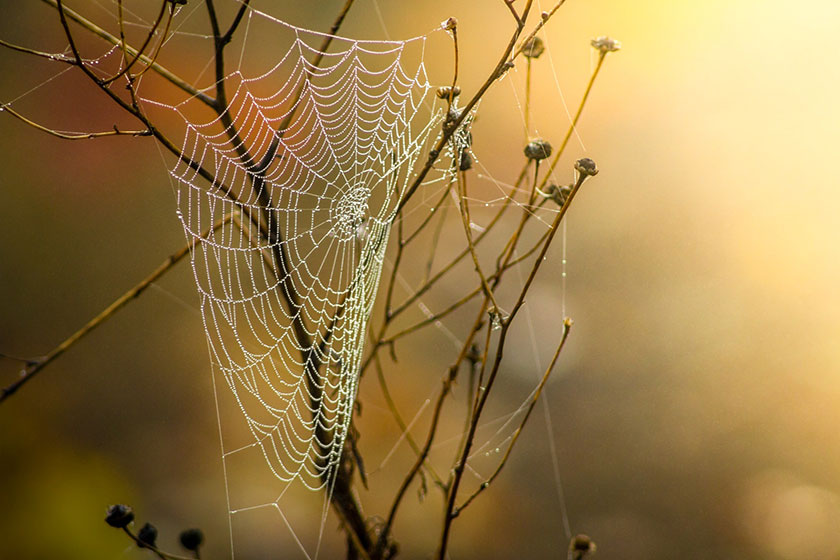
A dew-covered spider web in autumn.
Image courtesy of Pixabay, licensed under CC0.
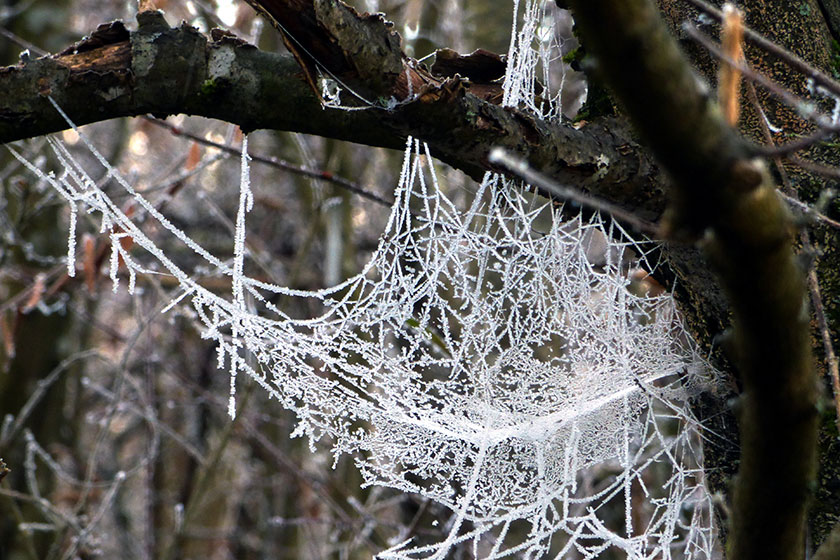
A spider web frozen solid in winter.
Image courtesy of pxhere, licensed under CC0.
Spiders build webs all year round, but autumn is the best time to spot them outdoors. Morning dew and mist droplets suddenly reveal a multitude of hidden webs that were previously virtually invisible thanks to the transparent nature of silk.
Autumn is often thought of as spider season for this reason, and because spiders tend to be fully grown at this time of year and searching for a mate, making it more likely we'll see them.
Frosty spider webs also make a stunning sight.
To get a better look at webs when they're not covered in dew or frost, you can spray a fine mist of water to make their fine details stand out. This won't harm the spider or damage the web - just make sure you use a clean spray bottle with no traces of chemicals.
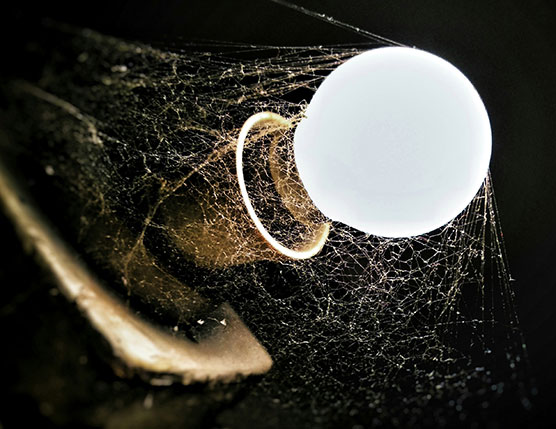
This web will catch insects attracted to the light.
© ad_soch/ Shutterstock.com
Location, location, location
Spiders use their webs to catch dinner.The choice of location is key to success.
Some spiders build their webs across potential insect flight paths. High-traffic areas such as near a light or window that's lit up at night are prime sites.
Other species place webs down low where crawling invertebrates are likely to wander by and horizontal webs can catch insects if they fall off the plant they were feeding on.
Types of spider web
British spider webs can be categorised into seven broad types: orb, sheet, tangle, funnel, lace, radial and purse.
Orb webs
These are the classic, two-dimensional webs that look like bicycle wheels or dart boards.
Orb webs are constructed with radial threads that function as a scaffold. The spider then lays down sticky threads in a spiral.
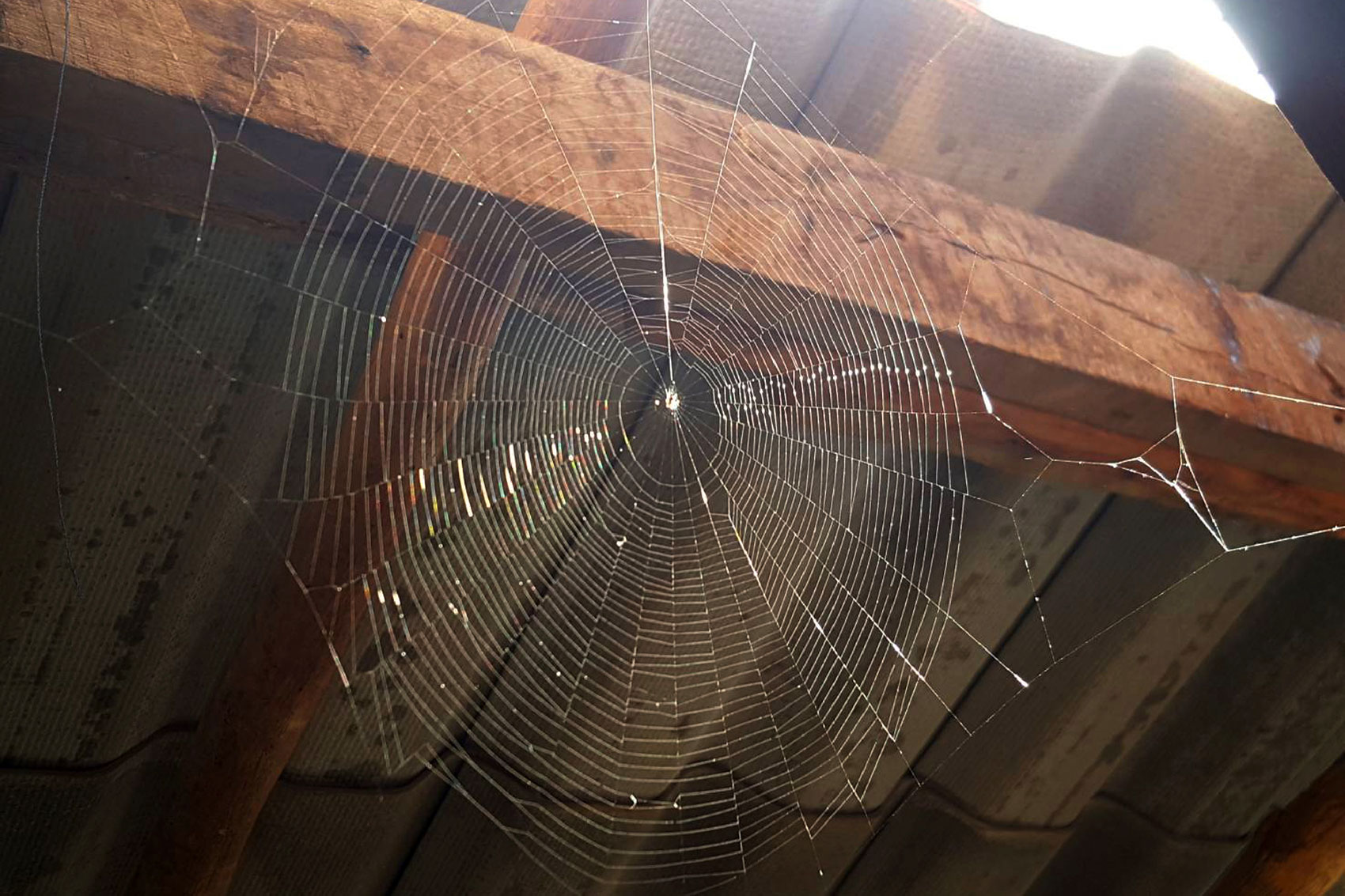
Classic orb webs look like a bicycle wheel.
© AMAM1990/ Shutterstock.com
Four UK spider families make this kind of web. Three coat the silk with sticky glue to hold captured prey in place: Araneidae, Tetragnathidae and Theridosomatidae. The fourth, Uloboridae, instead spins its web out of cribellate silk.
Jan Beccaloni, the Museum's arachnid curator, says 'Cribellate silk is very woolly. It acts like Velcro, sticking to the legs and bristles of captured insects.'
Garden orb-weaver
A member of the Araneidae family, the garden orb-weaver or garden cross spider (Araneus diadematus) is probably the best-known orb-web spider. True to its name, the garden orb-weaver is very common in gardens throughout the UK, but it occurs in a wide variety of habitats.
Jan says, 'Its web is a wonderful feat of natural engineering and can be very large, as much as 40 centimetres in diameter.'
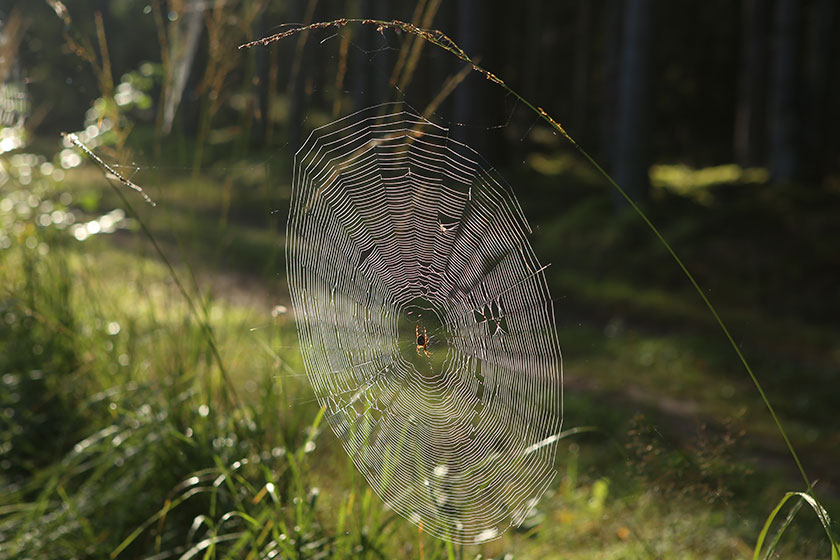
The webs of garden orb-weavers tend to be almost vertical and stretched across undisturbed spaces that are busy with insects such as flies, wasps and beetles.
© Giedre Vaitekune/ Shutterstock.com
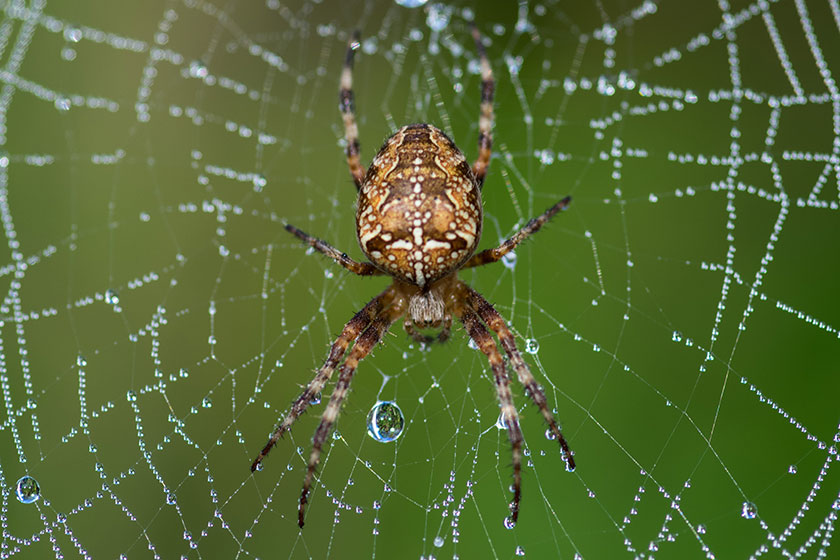
Close-up of the garden orb-weaver, Araneus diadematus. The abdomen of this spider is usually well-marked with a pattern of whitish spots that form a cross. Females can grow to 1.5cm long.
Image courtesy of Pixabay, licensed under CC0.
A new web takes about two hours to build. Step one is to drift a silk line across a gap on the breeze. After strengthening this supporting strand with extra threads, the spider adds the radial and spiral threads.
To finish up the web, the spider removes the central knot of threads and replaces it with a lattice.
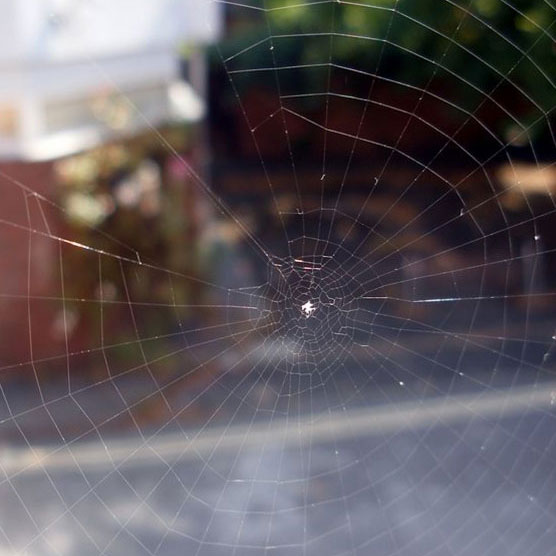
Web of Zygiella x-notata, with the typical missing sector top left.
Image © Anders Sandberg via Flickr, licensed under CC BY 2.0
The spider waits in a head-down position at the centre of the web or lies hidden among nearby vegetation where it remains in contact by means of a signal thread. When an insect flies into the web the spider approaches the source of the vibrations, bites it and wraps it in silk, to feed on later.
The missing sector orb weaver (Zygiella x-notata) constructs a very similar web, but one sector is left completely free of spirals. A strong signal thread passes through this sector to where the spider sits in its retreat. They're commonly found on the outside of window frames.
Webs spun by Tetragnathidae spiders, the long-jawed orb weavers, follow a similar pattern to Araneus webs, but there is a hole in the centre. This is often where the spider takes up position, spanning the hole with its four hind legs. The webs can be in pretty much any orientation, not just vertical.
Theridiosoma gemmosum builds a web derived from the typical orb shape. These small webs have an open hub and resemble an inside-out umbrella. The species is rare, found on low-growing plants near water in southern Britain.
Wasp spider
Some orb-weaver spiders add decoration to their webs: an extra band of silk called the stabilimentum.
This is particularly striking in the case of the wasp spider (Argiope bruennichi). It incorporates a zig-zag of dense, white silk down the centre of its web. What this is for still isn't known, but there are a few ideas.
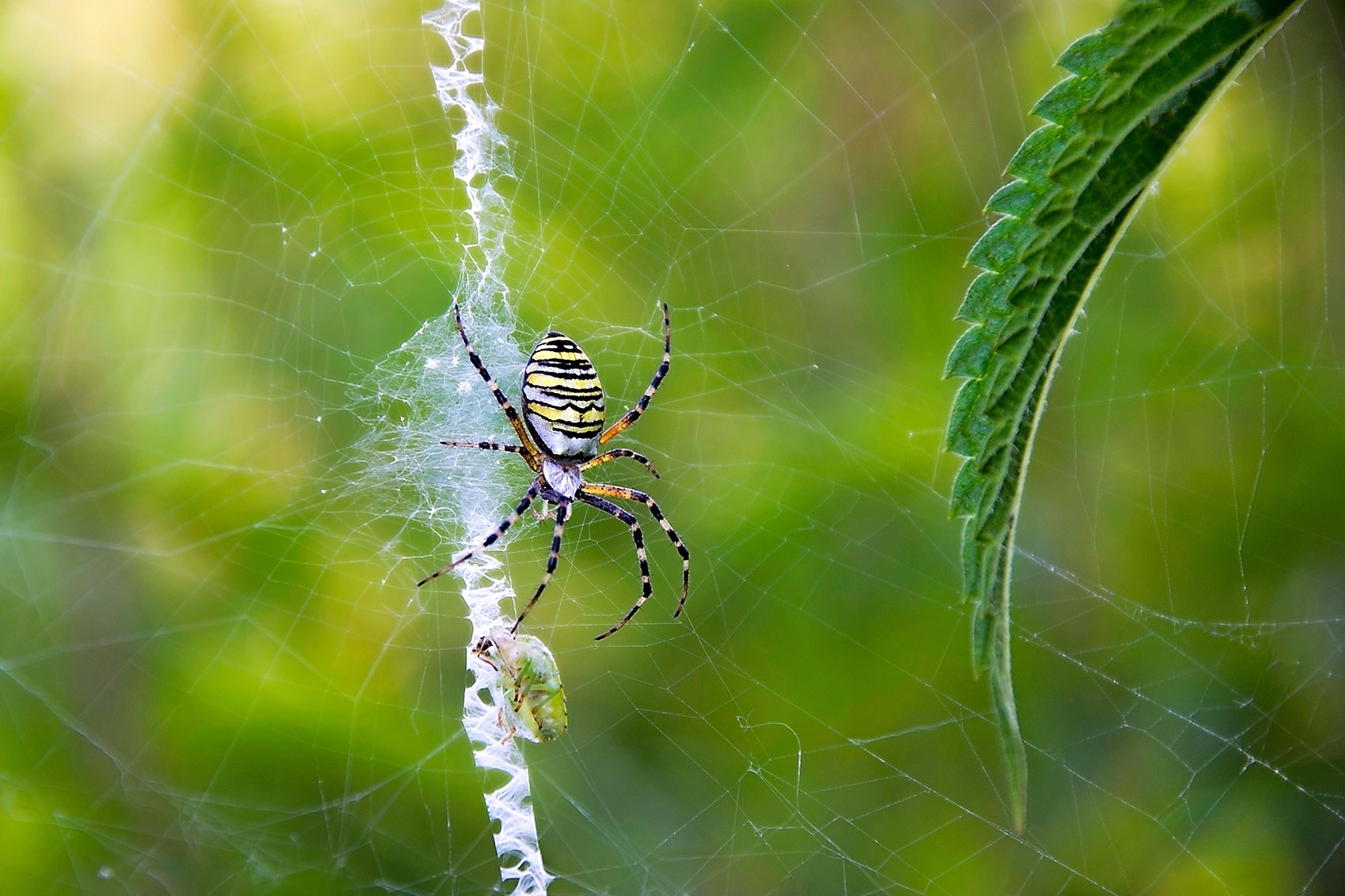
A wasp spider on its orb web, with prey stuck to the stabilimentum.
© AlisLuch/ Shutterstock.com
Jan explains, 'It's thought that some spiders may use a stabilimentum for camouflage. It may make them harder to spot on their web. Some spiders even attach the husks of their digested prey.
'Another popular hypothesis is that the stabilimentum helps attract insects to the web.
'A third suggestion is that the vivid patterns act as a warning to large animals, such as birds, that might otherwise accidentally destroy webs in their path. It looks like the stabilimentum has different functions depending on the species.'
When an orb web becomes badly damaged, or loses its stickiness because of the effects of wind and rain, the spider rolls the threads into a ball and eats them to recycle the silk components. This usually happens every day or two.
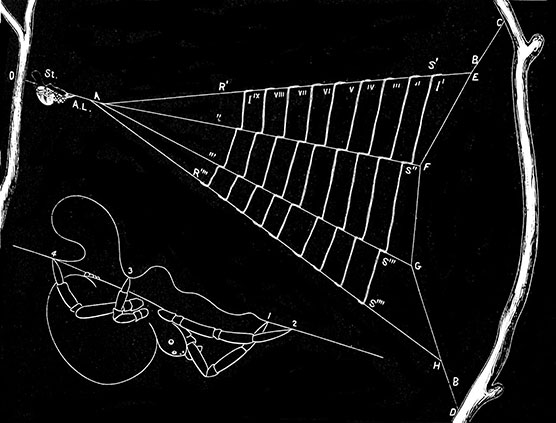
Diagram showing how Hyptiotes paradoxes keeps its triangular web taut, ready to snare prey.
Triangle spider web image from Wikimedia Commons, public domain.
Triangle spider
Hyptiotes paradoxus builds an unusual web that has earned the spider its common name, the triangle spider. If a circular orb web was a pizza, the web of Hyptiotes paradoxus would be a single slice. The spider also has quite a distinctive appearance. It is a fairly rare spider, present in England and Wales but not Scotland.
Jan adds, 'Your best chance of seeing it is likely to be on yew trees in graveyards.'
Hyptiotes uses its distinctive web as a snare. The spider sits on a nearby twig and holds taut a thread that runs to the tip of the triangle. Any unlucky prey caught on the web's fuzzy cribellate silk soon finds itself completely entangled as the spider immediately releases the thread, turning the web into a net, and then tightens it around its victim.
Garden centre spider
A relatively new arrival to Britain, probably imported on pot plants from the Netherlands, the feather-legged lace weaver (Uloborus plumipes) has spread throughout much of the UK over the past 25 years.
It has set up home in garden centres - where winter temperatures don't drop below freezing - and so it is often referred to as the garden centre spider.
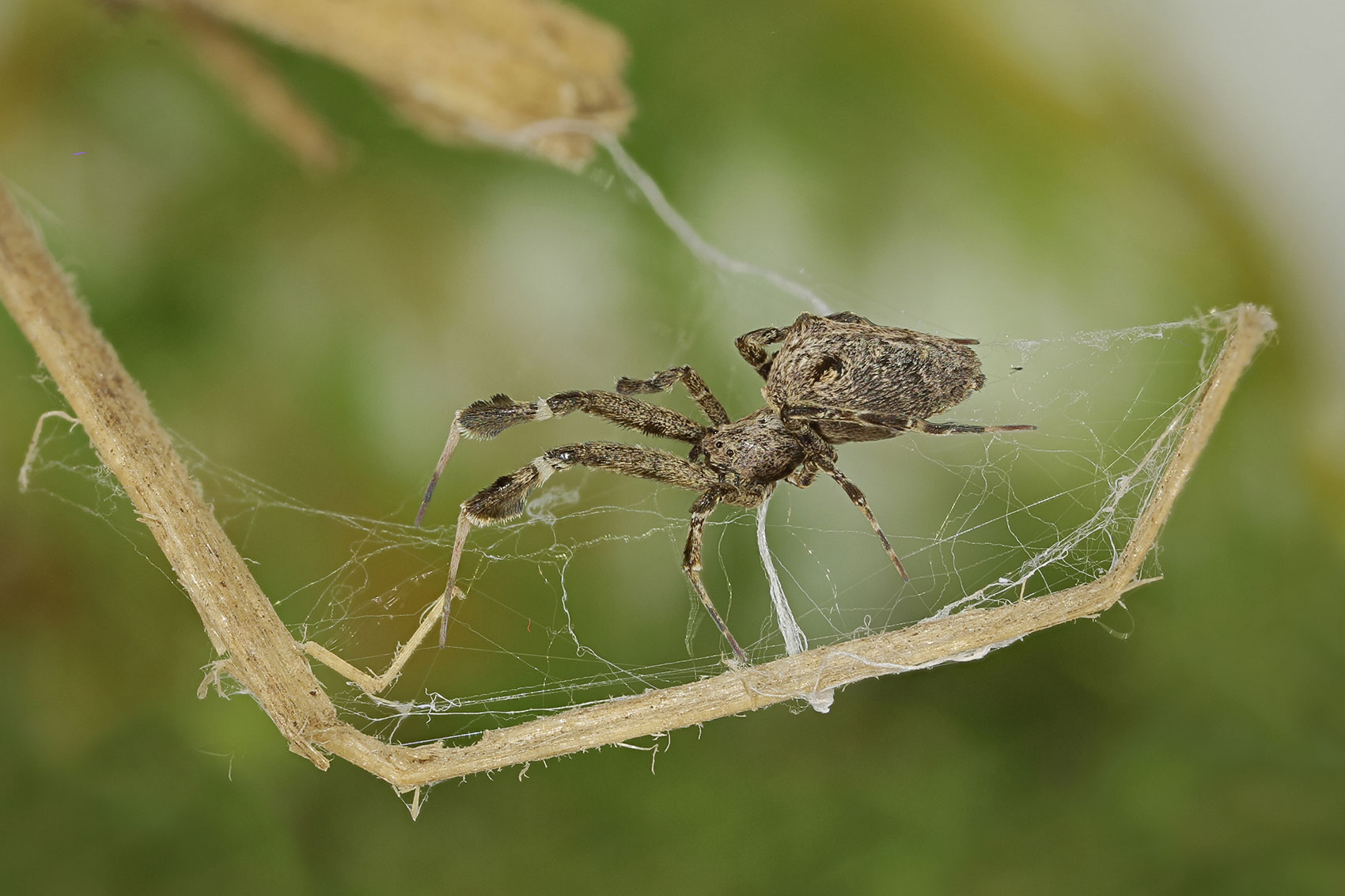
The garden centre spider, Uloborus plumipes, on its cribellate silk web, which acts like Velcro and stops prey escaping.
© Jiri Prochazka/ Shutterstock.com
The orb web of Uloborus plumipes is similar to that of Araneus diadematus but usually more horizontal - sometimes across the tops of plant pots - and the threads are fluffier.
The spider is an expert in camouflage, resembling dried vegetation when at rest.
Since the web often looks a bit scruffy, it gives the impression of an abandoned web with dead plant material stuck to it. Even the spider's egg sac looks like a dead holly leaf.
Researchers studying Uloborus plumipes have shown that cribellate silk is extremely fine (just a few nanometres thick - much thinner than most other silk) and the spider electrostatically charges the threads by combing them with specialist hairs on its hind legs.
Sheet webs
These densely woven, thin, horizontal sheets look like silken hammocks adorning grass and low bushes. Bugs fall onto the hammocks or get knocked down when they collide with a tangle of threads above the sheet.
Jan says, 'The sheer numbers of sheet webs visible on a dewy morning can take your breath away.'
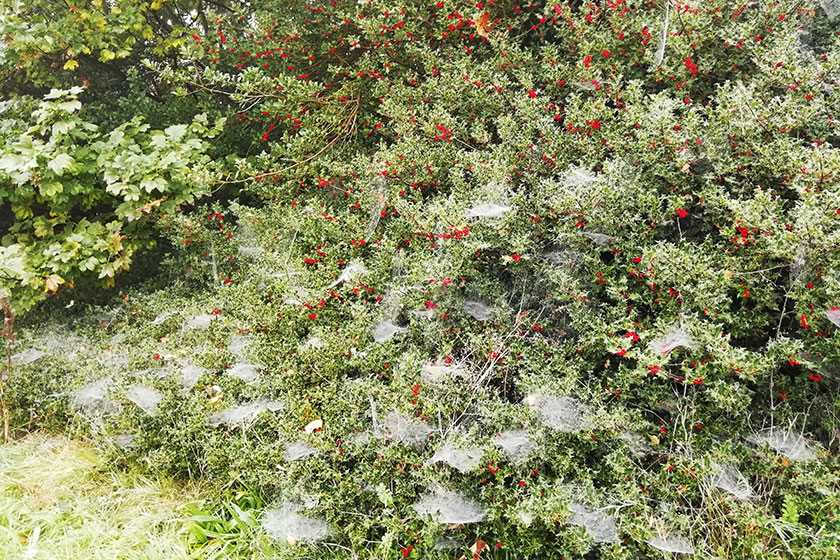
Dew revealed a multitude of sheet webs on this holly bush.
© James McNish
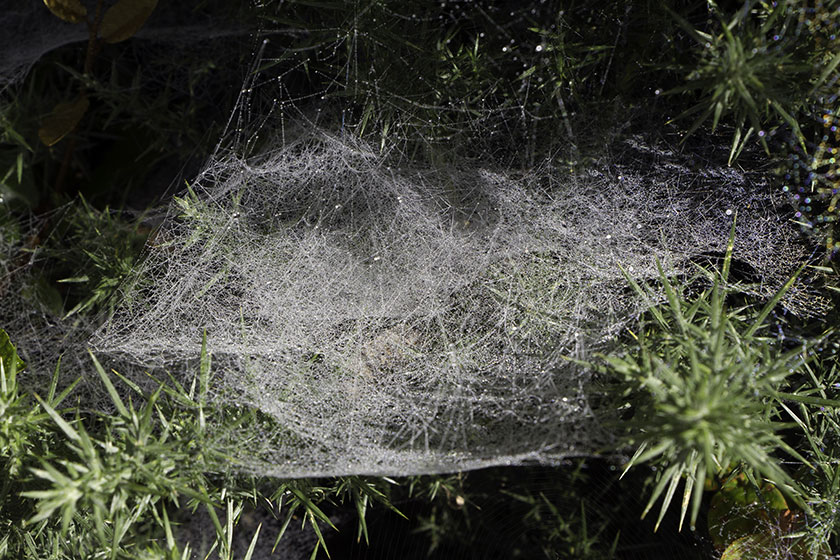
Sheet webs collect insects that fall onto them from above.
© Irelandimages/ Shutterstock.com
Sheet webs are usually built by the Linyphiidae. This is the largest family of spiders in the UK, with 280 species. It includes the tiny money spiders said to bring good luck if you find one wandering over you.
The smallest species tend to build their sheet webs on depressions in the soil, others on low vegetation and some on tree bark.
The money spider hangs beneath its web, waiting for dinner to land above.

A tangle web built by the daddy-long-legs spider.
Image © Luis Fernández García via Wikimedia Commons, licensed under CC BY-SA 4.0
Tangle webs
Like their name suggests, these webs look like a messy tangle of threads. They're often found in houses and collect dust as they age.
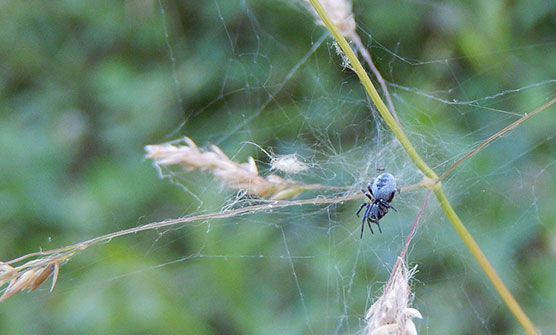
A Dictynidae spider on a web built over a few heads of grass.
Image © Luca Fornasari via Wikimedia Commons, licensed under CC BY-SA 4.0
Although they look like haphazard constructions, they're still effective at catching prey. These 3D webs are built by four families of UK spiders: the Dictynidae, Pholcidae, Theridiidae and Nesticidae (a single species).
There are seven species of Dictynidae spider in the UK. They create small, tangled meshes of cribellate silk, often building them over flower heads and under leaves, and also among leaf litter.
Daddy-long-legs spider
Pholcus phalangioides is the member of Pholcidae you're probably most likely to encounter, as it has become increasingly familiar as a house spider in Britain.
Fifty years ago it was quite rare here. A prolific breeder, it is now becoming very common, spreading northwards and living in centrally heated rooms all year round.
Pholcus phalangioides is a pale, delicate spider with long thin legs that hangs upside down on its flimsy, untidy web in the corners of rooms or behind furniture. If disturbed, the spider bounces up and down and becomes a blur.
It makes a good houseguest, consuming woodlice and other unwanted household pests. It also eats large spiders.
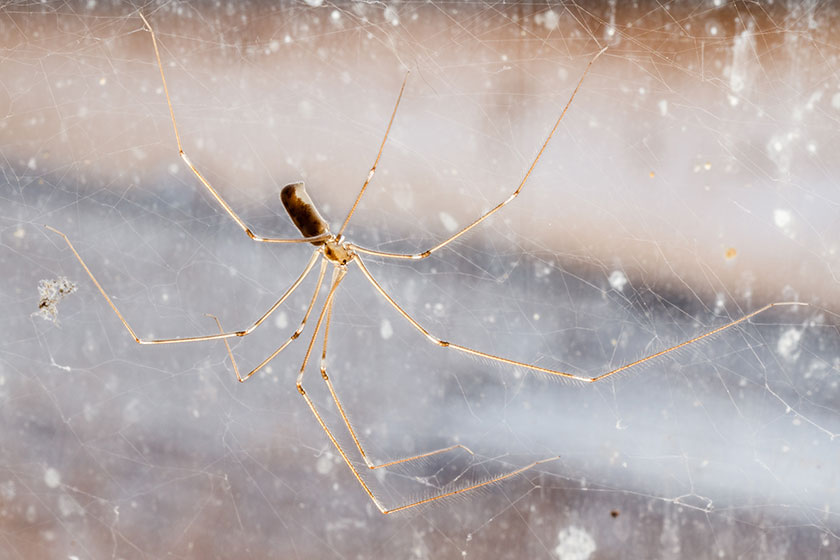
Pholcus phalangioides is a dainty looking spider.
© LFRabanedo/ Shutterstock.com
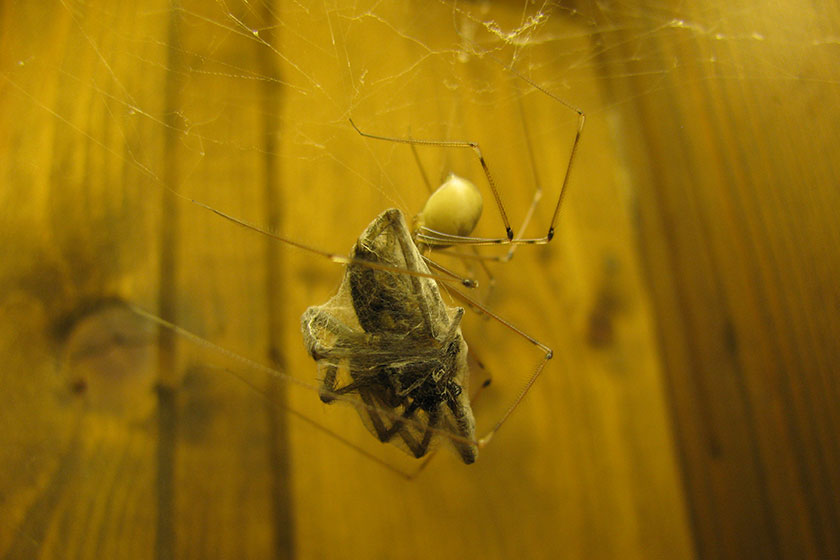
Despite its puny appearance, Pholcus phalangioides can take on large house spiders and win.
Image from McZul via Wikimedia Commons, licensed under CC0
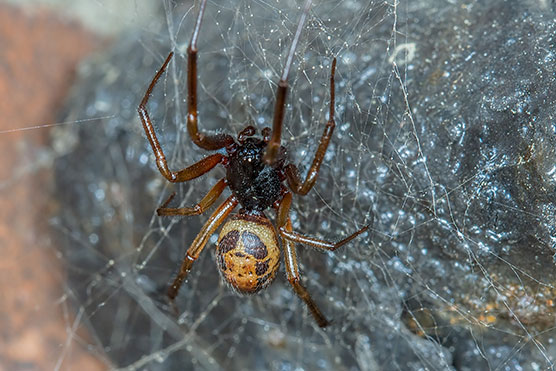
The noble false widow spider, Steatoda nobilis, on its messy tangle web.
© thatmacroguy/ Shutterstock.com
False widow spiders
The comb-footed spider family, Theridiidae, includes the much maligned false widow spiders (Steatoda species). Their webs are loose 3D frameworks of criss-crossing sticky threads.
Steatoda webs are usually found in buildings, sheds and garages or nearby under stones, in walls and garden fences. Two of the most commonly observed species are the noble false widow (Steatoda nobilis) and the cupboard spider (Steatoda grossa).
By day, Steatoda nobilis hides away in a silken retreat. This more densely woven section looks a bit like a funnel. From dusk onwards, it hangs upside down on its untidy web, which it usually builds at high level. This non-native spider prefers south facing aspects and conservatories.
The native Steatoda grossa prefers to make its messy web in dark corners among clutter in garages and sheds. It characteristically hangs or moves about this web upside down.
Funnel webs
They're made by just one family in Britain - the Agelenidae - which includes the labyrinth spider (Agelena labyrinthica) and house spiders (Tegenaria and Eratigena species). The overall shape resembles a funnel.
Living low down among grass, brambles, gorse or heather, the labyrinth spider typically spins a large sheet of closely woven silk that extends from a long tubular retreat at the rear.
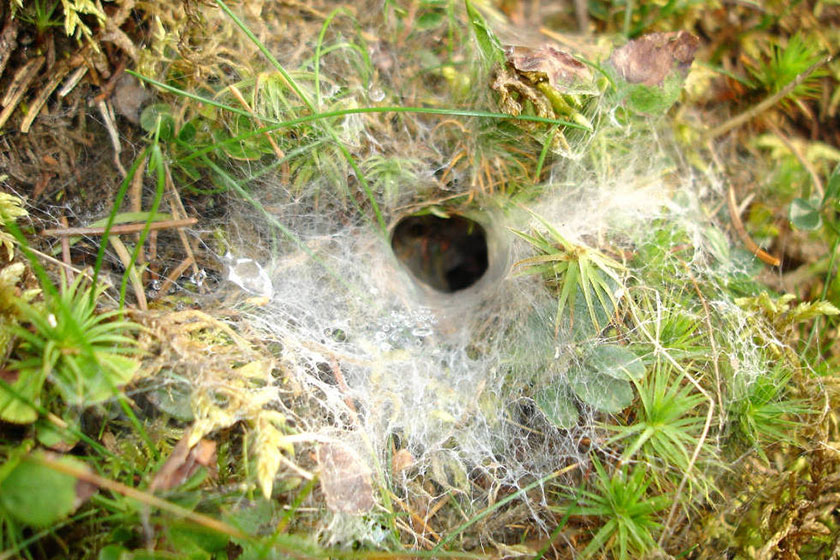
A funnel web built among vegetation.
Image © Saharadesertfox via Wikimedia Commons, licensed under CC-BY-SA-3.0
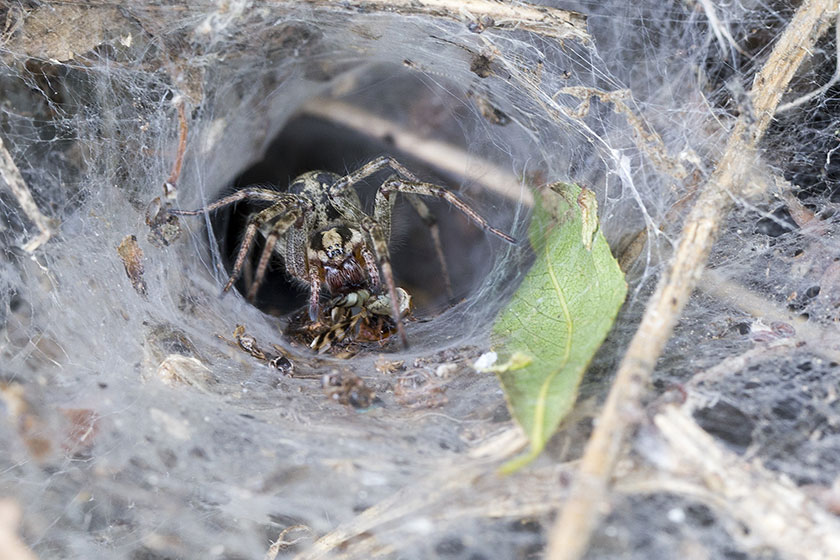
Labyrinth spider with prey at the entrance to its funnel web.
© Tony Mills/ Shutterstock.com
House spiders
Despite their name, house spiders can be found outside around hedges, rock faces and rabbit burrows, not just in houses. However, these do tend to be the spiders that unnerve us when they come dashing across our floors or become trapped in our baths - particularly in autumn when males go looking for a mate.
Some, including Eratigena atrica, Eratigena duellica and Tegenaria parietina, grow particularly large - with legs spans of around eight centimetres, and as much as 17 centimetres in T. parietina.
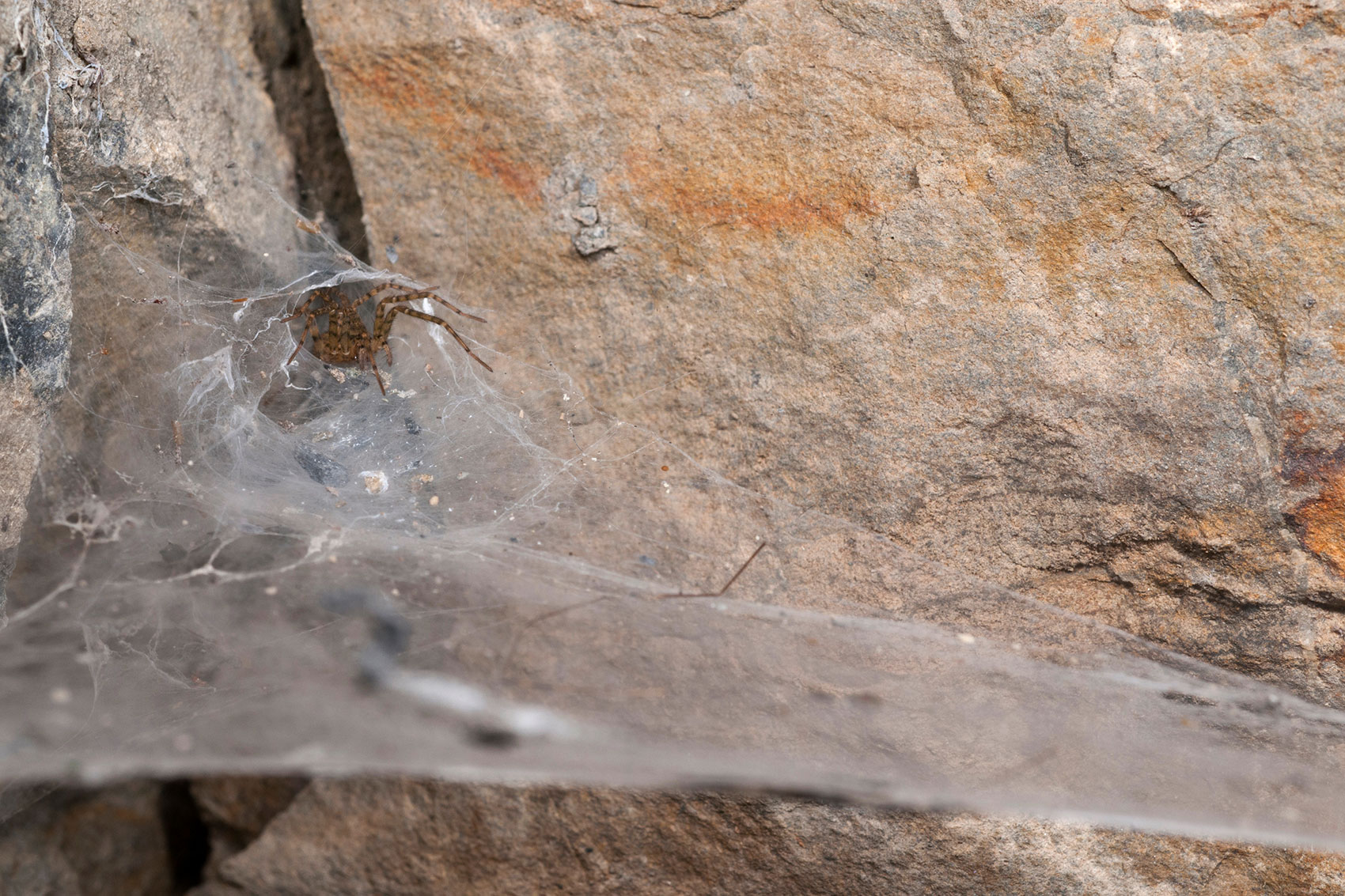
House spiders live outside as well as in buildings. Their funnel webs can include large sheets of silk as well as a tubular retreat. The webs can become very dusty.
© Federico Crovetto/ Shutterstock.com
House spiders spin large sheets of closely woven silk which funnels into a long tubular retreat at one edge. If their web is at the entrance to a hole, they just produce a collar of silk rather than a large sheet.
Several generations of spiders can refurbish the webs and they can attain considerable size and dustiness in an undisturbed cellar, shed or garage. These are what people often think of as cobwebs.
Lace webs
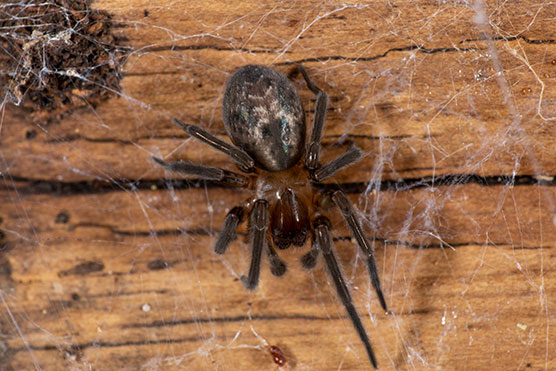
Amaurobius spider, with its lace web spread across wood.
© Jacqueline Kelsall/ Shutterstock.com
Lace webs are similar to funnel webs in that they also have a tubular retreat where the spider hides, but they are made of 'woolly' cribellate silk and the threads are more loosely spaced, looking more like lace than a silk sheet.
Only three species of lace web spider live in the UK. They all belong to the genus Amaurobius.
The webs are often spread out flat around gaps on walls, fences and window frames - particularly those of Amaurobius similis and A. ferox, while A. fenestralis webs tend to occur on dense vegetation like gorse, under stones and around cracks in tree bark.
Radial webs
This style of web has single lines of silk radiating away from a silken tube. The lines function as trip wires that alert the spider hiding inside the tube to prey wandering past. It dashes out at frightening speed.
Unlike most other types of web that entangle prey, this one simply alerts the spider to its presence. They hunt nocturnal insects such as moths and cockroaches, as well as bees and wasps.
Only a single family of UK spiders makes this kind of web: Segestriidae, which only has three species living in Britain.
Jan says 'This family has a unique leg arrangement. The hind legs hold on to the inside of the tubular retreat and the other three pairs face forward, touching the radial threads.'
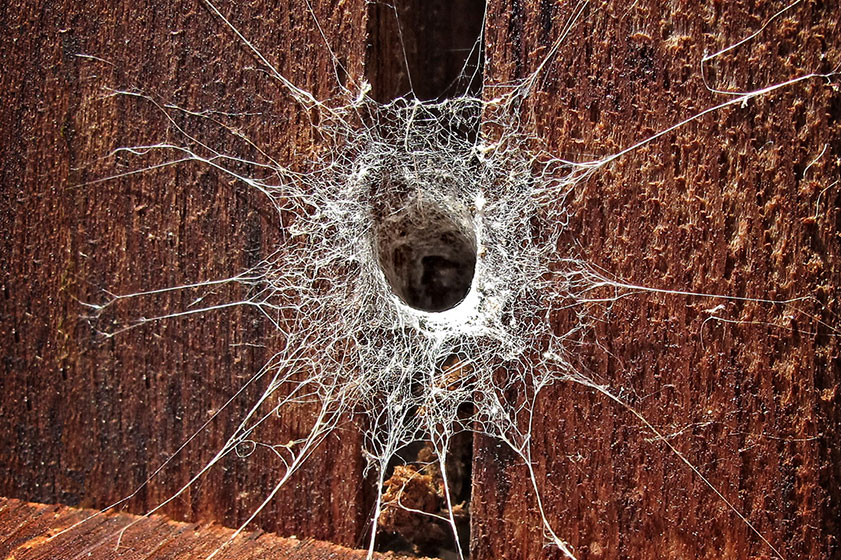
The trip wire threads are clearly visible on this radial web.
Image © crabchick via Flickr, licensed under CC BY 2.0
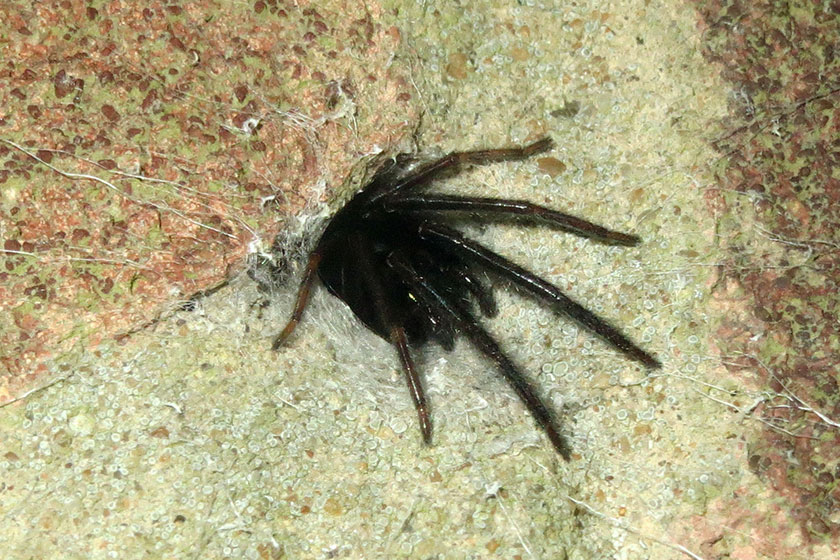
A tube web spider waits on the radial web it has built in a hole in a wall, ready to pounce on prey.
Image © David Short via Wikimedia Commons, licensed under CC BY 2.0
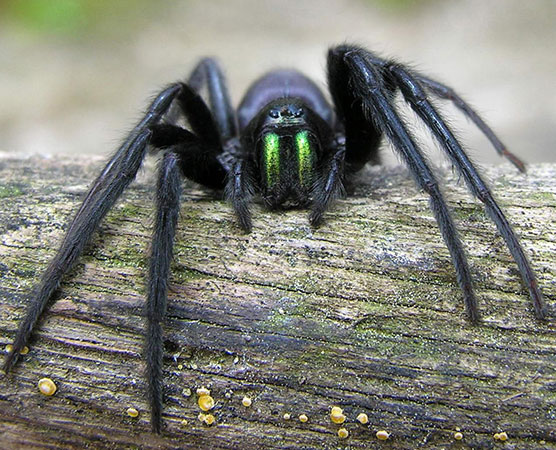
The shiny green jaws are clearly visible on this tube web spider.
Image © Luis Miguel Bugallo Sánchez via Wikimedia Commons, licensed under CC BY-SA 3.0
Tube web spider
The tube web spider (Segestria florentina) is the largest of the UK species of Segestriidae, with females growing more than two centimetres long. The spider is black or dark brown. The base of its jaws (chelicerae) are often a striking iridescent green.
Although restricted to southern England and Wales, mainly around old ports, reports suggest this originally Mediterranean species is spreading further inland.
These spiders tend to like living in crevices in old walls.
'They sometimes even excavate a bit of the old masonry to make a hole in which to spin their tubular web,' adds Jan.
Purse webs
Only Atypus affinis builds this type of web and is known as the purse web spider.
This spider is the only tarantula relative in the UK. Its fangs are orientated differently from those of other UK spiders, projecting downwards.
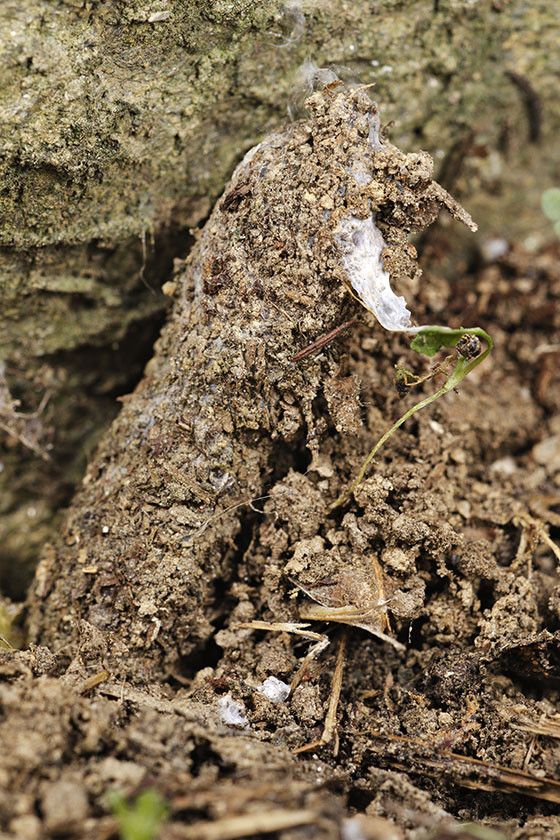
The long silk tube of this purse web is covered in soil and debris, camouflaging it.
© Marco Maggesi/ Shutterstock
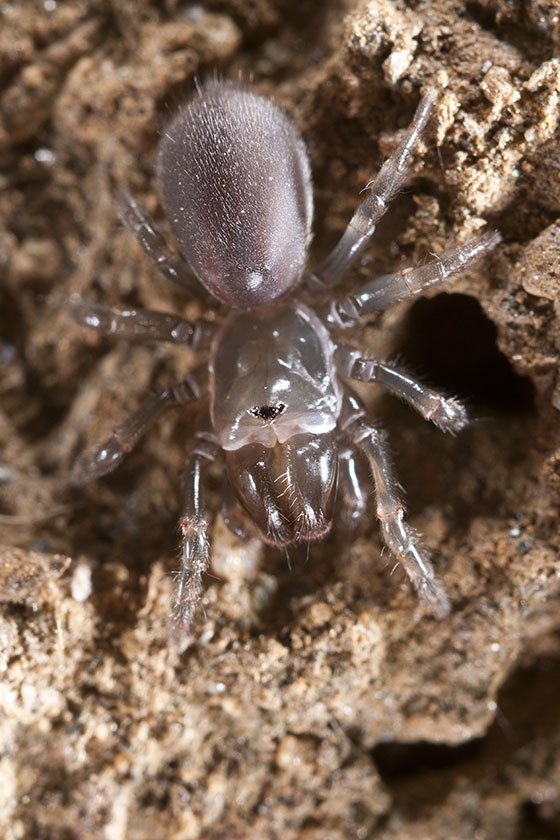
The purse web spider, Atypus affinis, is the UK's only tarantula relative.
© Federico Crovetto/ Shutterstock.com
Atypus affinis digs a long underground tunnel and lines it with silk. The long silk tube has a usually sealed end that extends above ground, where it lies on the top of soil at the base of grass, looking a bit like a sock or purse. This part of the web becomes well-camouflaged by soil and debris.
This is part of the spider's cunning hunting strategy, explains Jan:
'The spider hangs upside down inside the sock shape. If anything crawls across the outside, the spider reaches through and grabs hold, piercing the tube wall and the victim with its fangs. It then drags the subdued prey through the web into its lair and repairs the hole.'
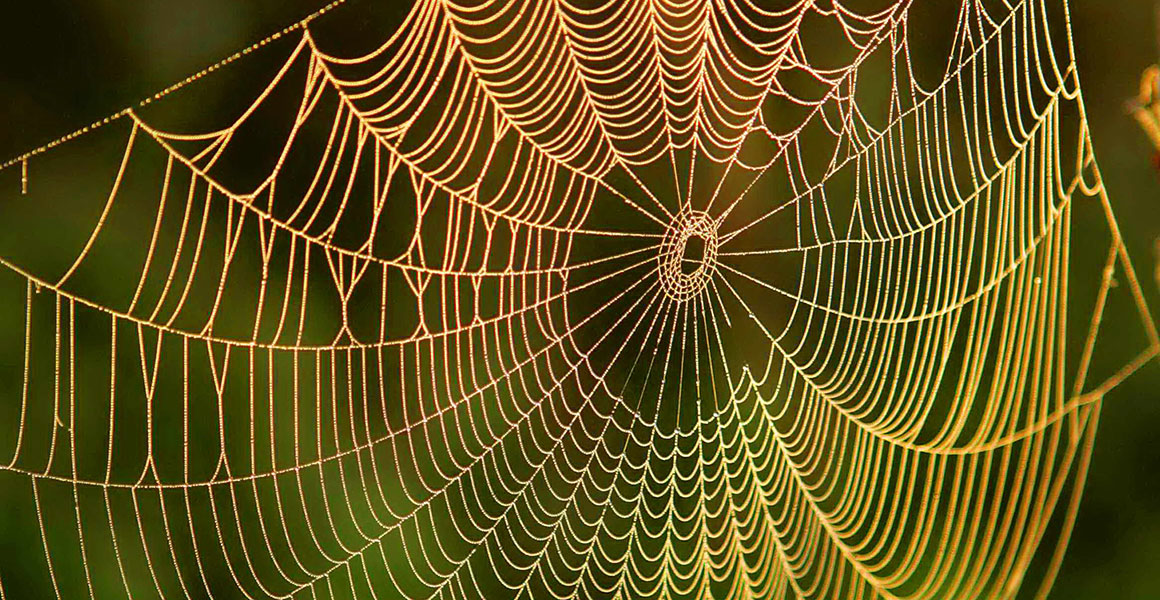
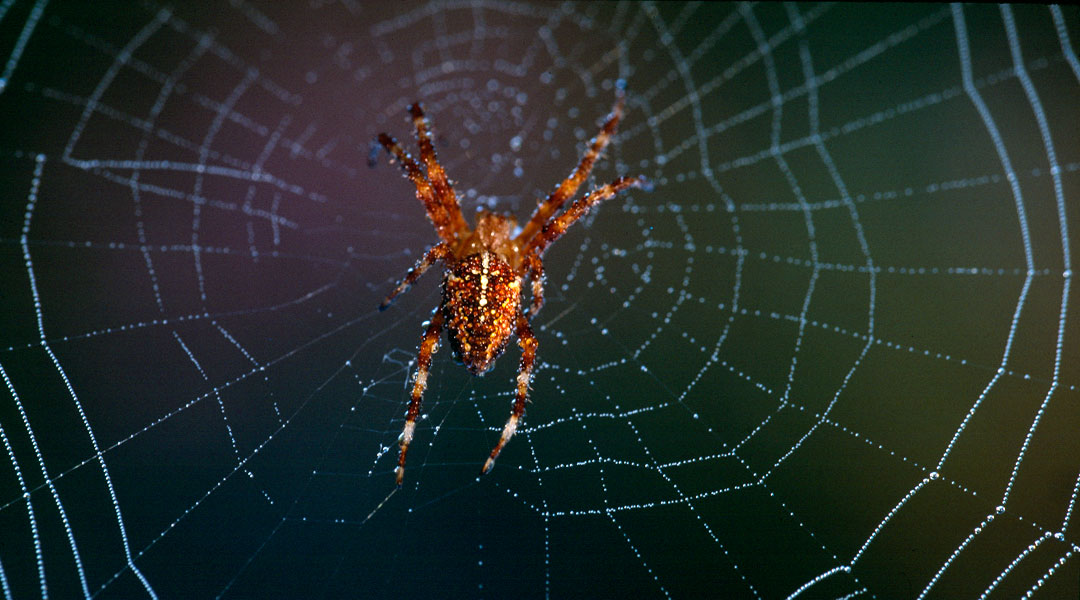
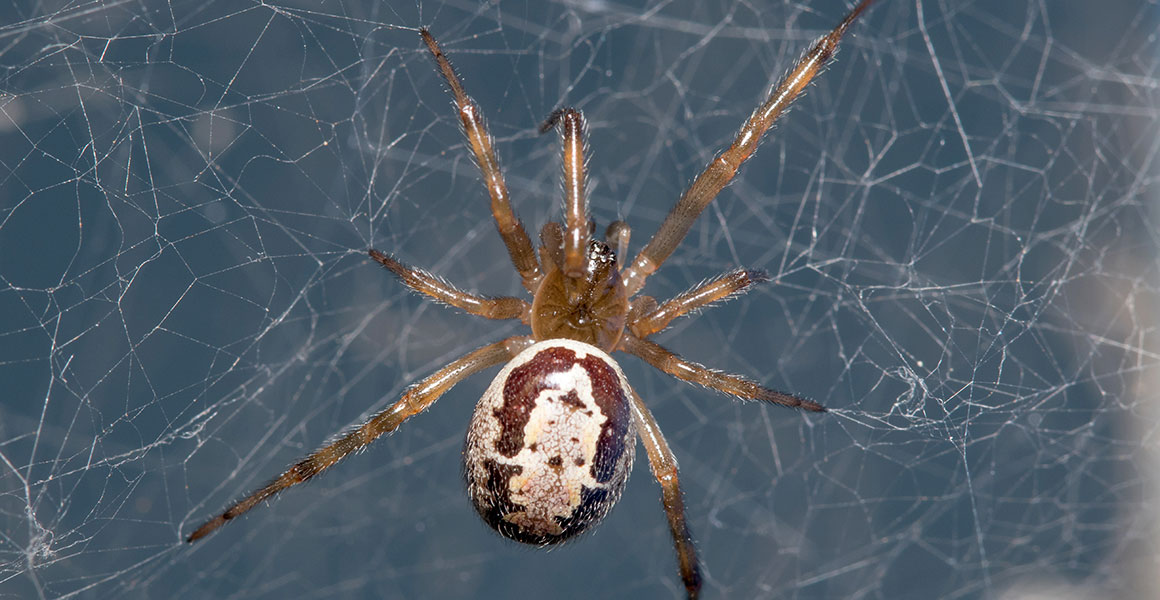
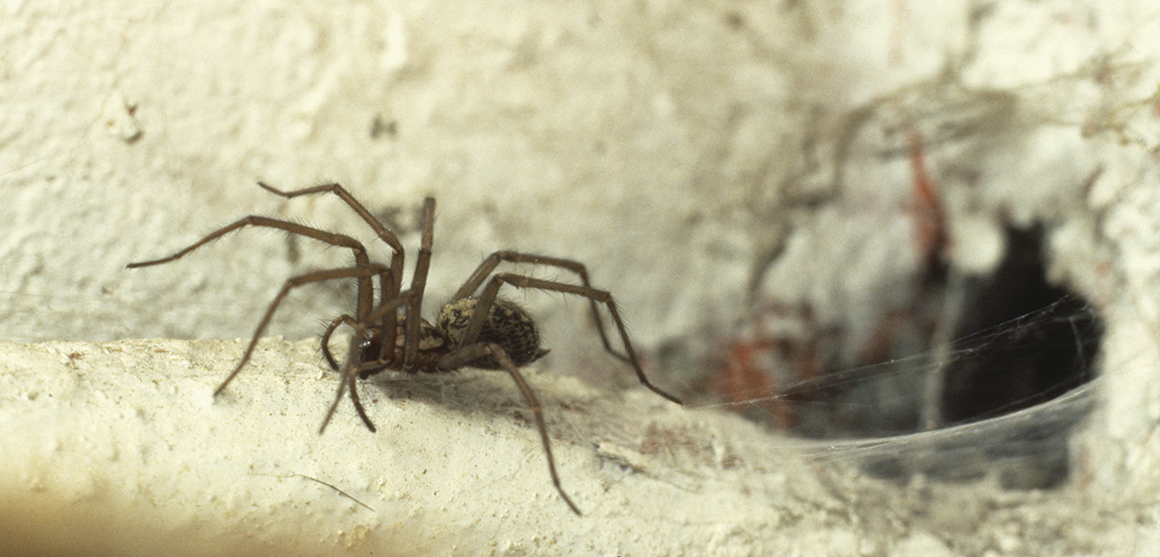
Don't miss a thing
Receive email updates about our news, science, exhibitions, events, products, services and fundraising activities. We may occasionally include third-party content from our corporate partners and other museums. We will not share your personal details with these third parties. You must be over the age of 13. Privacy notice.
Follow us on social media